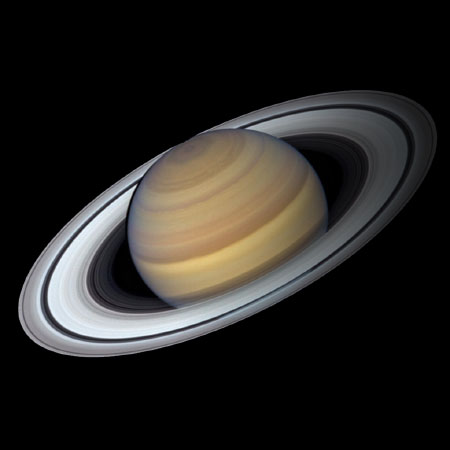An experienced observer may tell you that when it is first rising is not the ideal time to view a planet; ideally you should wait until it is high in the sky, so you are looking through less atmosphere. However, we’ve been waiting many months for Saturn’s return and, in fact, there is really no bad time to view this stunning object. More important, early evening in March is arguably the best time to display the planet to non-astronomers. It’s prime time; people are outside walking or shopping; kids are still awake.
This mix of convenient timing, a spectacular observing target, and the approaching end of winter, marks the beginning of the public outreach season for those of us who love that aspect of this hobby. Now is the time to arrange astronomy demonstrations for schools, community groups such as scouts and guides, and for sidewalk astronomy simply setting up your scope somewhere that passers-by will say “whatcha lookin at?” and letting them see.
Table of Contents
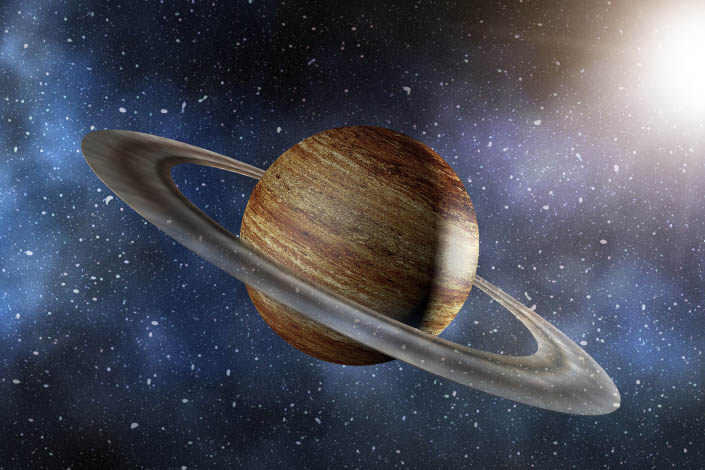
Finding Saturn
Beginners are sometimes puzzled that planets are not shown in long-term star charts like published “star atlases”. This is because, unlike the stars, they move a significant distance in the sky from year to year. (This motion is what made ancient observers realize something special was going on with those bright points of light, and it made developing early models of how the Earth, Stars, and Sun moved in relation to each other very challenging.)
So, to find planets on star charts, you need charts published for specific dates. The outer gas giants such as Saturn and Jupiter move slowly enough that annual charts are good enough, while the inner planets such as Mercury move so much that you will need charts published for specific months.
Observing Saturn
While Saturn is beautiful under any conditions, the best observation of planets is on nights of good “seeing”, meaning nights when there is limited thermal turbulence in the upper atmosphere. The Clear Sky Chart predictions for Seeing will help you locate those rare perfect evenings.
To see Saturn as a ringed planet, you will need some magnification. At about 20x magnification, you will see that it is not a star, and that it is also not a simple round disk. Somewhere between there and 100x you will first see the rings; at 100x the sphere and rings are tiny, but will be sparkling clear and sharp, and this view is something you should include in your observations. If your telescope permits, however, you should try for 150x to 200x, which will give a stunning view of the planet, the distinct ring system, and the pitch black gap between the rings and the planet. Observers with access to larger apertures will enjoy using 300x or more on nights of good seeing.
With good seeing and careful focus you may be able to see the space between the rings and the planet, the shadow of the planet on the rings or of the rings on the planet, and possibly the gaps inside the rings. The largest gap, visible in most telescopes, is called the Cassini Division. The fainter Encke Division is a challenge target for mid-sized amateur scopes. You may also be able to make out the subtle banding in the atmosphere, caused by the high winds and rapid rotation of the planet, but much less distinctive than the equivalent markings on Jupiter. Finally, you should be able to see several of Saturn’s dozens of moons arranged around the planet, in line with the plane of the rings.
Some Information about Saturn
Your observation of Saturn may be more enjoyable if you are armed with a few interesting scientific facts about the planet, and they can certainly make a conversation with a visitor more interesting and stimulating. New information about Saturn is coming in rapidly with the exploratory spacecraft in that region.
Rings
Saturn’s rings are, of course, its most obvious and spectacular feature. But did you know it is not the only ringed planet? In fact, all 4 of the gas giant planets (Jupiter, Saturn, Uranus, and Neptune) have rings, but only Saturn’s are visible from Earth with amateur telescopes.
Saturn’s rings are generally believed to be a “failed moon”, that is, material collected during the formation of the planet but which was unable to coalesce into a solid body because it is inside Saturn’s Roche Limit the distance inside which a planet’s tidal forces overwhelm a satellite’s own gravitational forces, preventing it from holding together. (Small rocky satellites, held together by chemical cohesion, can exist inside the Roche limit but no large satellites exist inside their parent planet’s Roche limit. On the other hand, every gas giant’s rings are inside their planet’s Roche limit.)
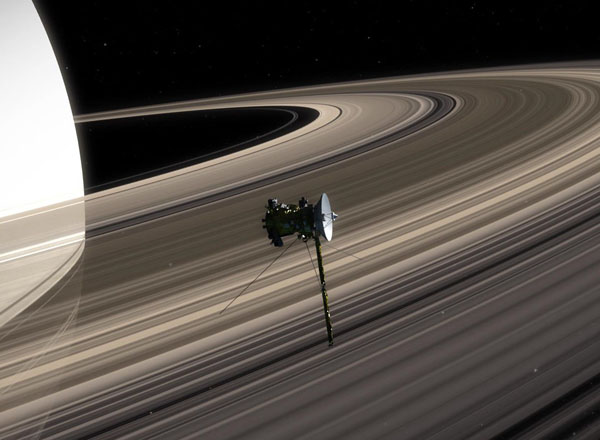
The sharp, crisp boundaries of the rings are believed to be defined by the effect of “shepherding satellites” moons orbiting in the region whose gravity and tidal forces act to clear particles from the orbit outside specific regions. The rings do not dissipate over time because the particles are being replenished by material swept off small inner satellites by friction and tidal forces.
Rings “Disappearing”
The plane of Saturn’s rings is not perfectly aligned with the plane of Saturn’s orbit around the sun. I.e. the planet’s axis of rotation is not perfectly perpendicular to the plane of its orbit. (Neither is ours, that’s what causes our seasons to change.)
So, as Saturn and Earth move around the sun, the angle at which we are viewing the planet changes. We spend time looking “up” at the underside of the planet, then the angle gradually rises until we are looking “down” at the upper hemisphere. This cycle takes a little more than 28 years. So, twice in this cycle about every 14 to 15 years our angle of view crosses the mid-point of Saturn, and we are looking exactly at its equator.
You can see this happening by watching the rings. When we are looking up at the planet from below, or down from above, we get a good view of the rings’ surface. But as our view approaches Saturn’s equator, we look at the rings closer and closer to edge-on. The rings are so thin (only a couple of hundred kilometres thick) that we see less and less of them as our view aproaches edge-on. When we are looking exactly edge-on, they will disappear entirely for a few weeks.
Moons
Saturn has so many moons that any published count is probably incorrect. As I write this about 50 have been discovered, of which 35 have been officially named.
The most interesting moon to contemplate or to point out to visitors is Titan. It is the only moon known, with certainty, to have liquid on its surface, because a probe was successfully landed there in 2005. The temperature is far too low for liquid water, and the liquid is believed to be Methane.
The planet itself has an interior rocky core surrounded by a very thick atmosphere of mostly Hydrogen and Helium. There is so much gas that, on average, the planet’s density is less than that of water. In other words, if you had a big enough puddle, Saturn would float.
Like the Earth and all the gas giant planets, Saturn has a magnetic field. However, unlike any other planet, the magnetic axis is almost precisely aligned with the rotation axis. In other words, the magnetic North Pole is at the real North Pole.
Titan Unveiled
Whenever a planet or moon is cloaked in its own atmosphere, whether its smog, haze, or cloud, it evokes a sense of intrigue and mystery. Saturn’s largest moon Titan fits the bill perfectly. This planet-like satellite has up till now rendered observation difficult to say the least. Since the 17th century, both smog and distance kept Titan’s secrets at bay.
Astronomers of antiquity including Christiaan Huygens and Giovanni Cassini observed nothing more than a pale orange pinprick of light next to Saturn’s orb. Observations of this tiny world prior to the space age were bleak. Features resembling two round white patches in its cent er and some darkening near the edges of Titan’s disk were reported by Spanish astronomer, Jose Comas Sola in 1907- But as far as other newsworthy details, there was scant little.
The next big observational event came during the 1940″s when Gerard Kuiper postulated that the moon had its own sustainable atmosphere. A 1949 best selling book entitled, “The Conquest of Space” by Chesley Bonestell featured on its cover a Titanian landscape complete with blue skies. It was the best work of space art ever created. Today we know that the sky over Titan doesn’t even come close to Bonestell’s description. However, it was a breathtaking picture.
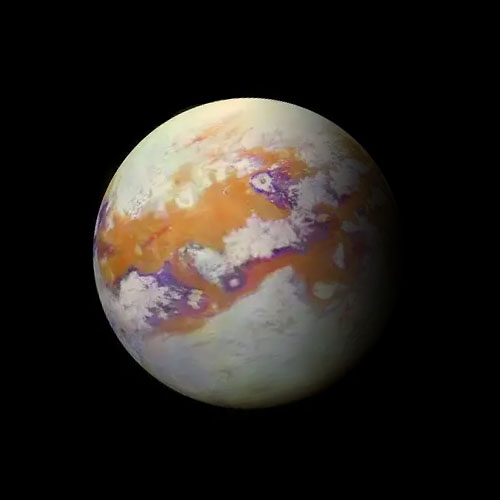
Eventually it was time for technology to step in. In 1979 the first artificial probe to visit the Saturnian system was Pioneer 11. The first ever close-up portrait of Titan was snapped on Sept. 2, 1979. Pioneer 11 also determined that the moon had a hostile climate a climate too cold for life. With more technology now available to us, it would soon be a matter of time when Titan’s secrets would be revealed to humanity.
In 1980 both Voyager probes sent back images of an orange-tinted orb but were unable to penetrate the dense layer of haze. Planetary scientists had their suspicions about lakes and seas that were filled with methane or ethane. Soon it was discovered that the skies over Titan were saturated with hydrocarbon- based molecules. Any biologist knows these molecules form the basic building blocks of life.
In October 1994, astronomers used the Hubble’s Wide Field and Planetary Camera (WFPC) in the near infrared to peer through the layer of haze. Finally, for the first time, some indications of surface detail were seen. Although crude, Hubble saw areas of light and dark on Titan’s surface. Were these hydrocarbon oceans or dark deposits on solid surface?
Obviously, Titan was still being a bit of a tease for planetary astronomers. More news would have to wait for another decade until Earthlings would send the much anticipated Cassini-Huygens craft to the Saturnian system. Regarding planetary exploration, Cassini-Huygens would revolutionize imaging and data collecting. Carrying a synthetic aperture radar or SAR, similar to the one Magellan had between 1990-94 to study Venus’ cloud cover and map its surface, it would capture high-resolution images of Titan’s Earthlike topography. Cassini also has near infrared capabilities as well to peer through the thick orange haze. This comprehensive mission unravelled mysteries of Titan’s varied landscape including finding liquid hydrocarbon lakes in the northern latitudes.
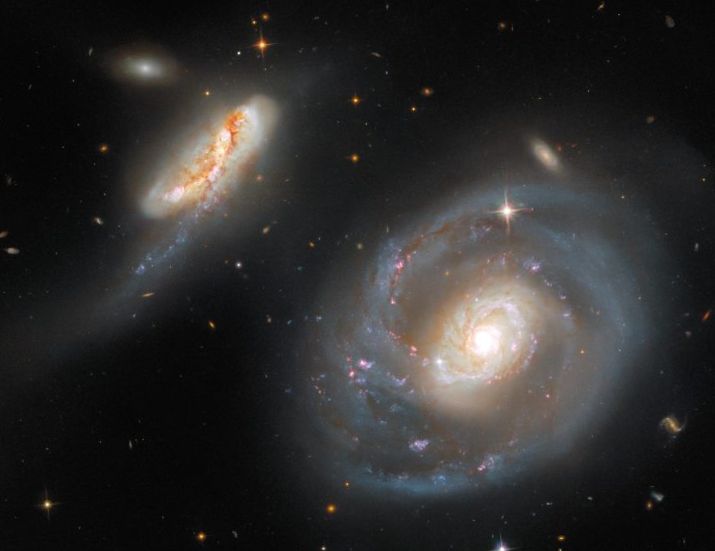
When the ESA’s Huygens probe was dropped into the moon’s atmosphere in January 2005, it began collecting data and sent it back to Earth for mission scientists to decipher. What Huygens saw resembled Earth in many ways. River-cut hills, dry-lake beds, drainage channels from higher elevations to low-lying areas, sand or ice dunes, and yes, even ice volcanoes to name a few. It took Huygens several hours to make a soft landing upon the moon’s alien surface. Initially, mission scientists thought the craft had landed in a muddy substance, similar to saturated clay on Earth.. But an onboard penetrometer later confirmed that the probe had lighted upon a pebble and overturned it as it came to rest. The immediate area around the lander had no open areas of liquid, although liquids may have flowed in the not-so-distant past. Easily visible were roundish pebbles perhaps made of water ice due to the action of fluids.
It is interesting to note that during Huygens descent toward the surface, instruments were unable to determine which angle the Sun was shining from. Titan’s opaque blanket of methane and ethane prevents a good reflectance spectrum of its surface to be obtained. Thickness estimates range anywhere from 200 to 880 km. That’s many times thicker than Earth’s atmosphere. Decades ago, it was this thickness that led astronomers to assume that Titan was the largest moon in our solar system. Today we Know that Titan ranks second after Jupiter’s Ganymede. In a nutshell, Titan’s complex atmosphere is considerably thicker than our’s, composed of 98.4% nitrogen and 1.6% methane. Trace amounts of hydrocarbons, argon, carbon monoxide, cyanogen, and helium make up the balance. The thick orange smog we see in images of the satellite is a by-product from the Sun’s ultraviolet light breaking up methane molecules which form hydrocarbons in the upper atmosphere.
In 2004, Cassini discovered that the moon is a “super rotator” much like Venus. Here we have a world where the atmosphere rotates much faster than its surface. Occasionally molecules in the upper atmosphere become ionized and then whisked away when the satellite sometimes orbits outside Saturn’s magnetosphere. Both the moon and its atmosphere evolve, undergoing changes throughout its 4.5 billion year history. Scientists haven’t discounted the theory that biological processes may be replenishing the methane in Titan’s atmosphere. Unfortunately the mission was not intended to sniff out life forms, so a “biological” mission, may be decades away.
Oddly enough, the surface is much colder than the upper atmosphere because the haze acts as an anti-greenhouse agent by reflecting sunlight back into space. Temperatures on the ground plummet to a frigid -I79°c. If life needs a niche on Titan, it would need to find places beneath the soil. Huygens also noted that liquid methane and other organic compounds periodically rain upon the surface. In October 2007, instruments recorded an increase in opacity in the clouds above an equatorial region dubbed “Xanadu”. This was suggestive of methane drizzle, but not necessarily rain. Methane, ethane, and other organic material was detected by Cassini in December 2006 in a large 2,400km cloud which was still visible one month later. Downdrafts located at high northern latitudes drive organic particles to the surface. This was the best evidence yet for the hypothesized “methanological” cycle. This process is analogous to our own hydrological cycle here on Earth. Clouds cover about 1% of the moon’s disk, but outbursts have been recorded when cloud cover expands to as much as 8%. Current models that match well with observations tell us that Titanian clouds cluster at preferred coordinates and that cloud cover varies by distance from the surface on different parts of the moon.
A visiting astronaut would find the terrain eerily similar to Earth’s. Although geologically young. Titan has a complex, fluid processed surface. Cassini used radar to detect rough and smooth areas, what appeared like volcanic features, mountains, valleys, chasms, and perhaps bodies of liquid of either methane or ethane. The jury is still out regarding the existence of liquids on the surface. There was good indication that there were lakes or seas filled with methane, especially in the northern latitudes. If these are indeed depressions filled with some type of liquid, it would mean that humanity has found the first stable bodies of liquid that is not of this Earth. Repeated flybys by Cassini will determine if they are genuinely of a liquid state.
The first suspected lake was located at the south pole, named oddly enough, Ontario Lacus. In the north polar region a body of liquid larger than Lake Superior was also detected. The SAR radar will be used at a later date to determine if any wind is blowing on the surface of the liquid or whatever happens to be down there. Surprisingly very few impact craters have been found on Titan. The theory is that because the surface is young and dynamic, fluvial processes continue to erase crater-like depressions. A second theory relates to Titan’s thick blanket of haze. Being much denser than Earth’s, it offers twice the protection against incoming debris. Surface features dubbed “crateriforms” were imaged as well. These are circular markings that may be impact related, but they lack specific traits to confirm that they are the real thing. Of course more news of these and other anomalies will develop as the mission continues.
We know that volcanism (past and present) is fairly common in the solar system. On Titan, there is preliminary evidence of water and ammonia plumes that disgorge from surface volcanoes. Methane was found spewing from a suspected cryovolcano as well. These ice-volcanoes may be replenishing the methane in the moon’s atmosphere. This issue has yet to be settled. Cryovolcanism may be a tour de force that is constantly shaping Titan’s surface. Grain-sized ice and ammonium sulphate ash continually build-up the surface forming “pancake domes”. These are flat-topped volcanic mountains built up by either molten rock, magma, or in Titan’s case, cryomagma. Cryomagma is a mixture of melted water and ammonia that wells up from a suspected water/ammonia ocean 400km below the surface.
Planetary scientists glimpsed a large, circular feature about 180km wide resembling an Earth-type shield volcano. They named it Ganesa, after the elephant-headed Hindu god. Hawaii’s Big Island volcano bears some resemblance to it. Upon closer examination, one can see a process of multiple lava flows trailing down the mountain. Astronomers think that volcanic activity continues today, therefore they will be on the lookout for evidence of it in future flybys. They hope to catch one in the process of “blowing its top”,
In the early part of the 21st century, ground-based telescopes imaged large areas of dark terrain straddling the equator. Before Cassini’s rival, these dark regions were thought to be seas of organic matter liquid hydrocarbons. Cassini’s radar revealed these areas to be tensive plains covered in towering sand dunes as high as 300 meters, Variable winds blowing in one direction or alternating between two different ways may account for these dunes. They are built-up in long parallel ridges that are aligned from west to east. In mountainous regions these dunes break-up where wind direction shifts.
Tidal forces from Saturn affect Titan’s atmosphere and tends to drive the wind toward the equator. The dunes’ composition still remain a mystery; sand is one alternative, while according to theory, liquid methane rained eroding the ice bedrock causing flash floods. A combination of ice crystals and organic solids produced by photochemical reactions in the atmosphere may also account for the dunes.
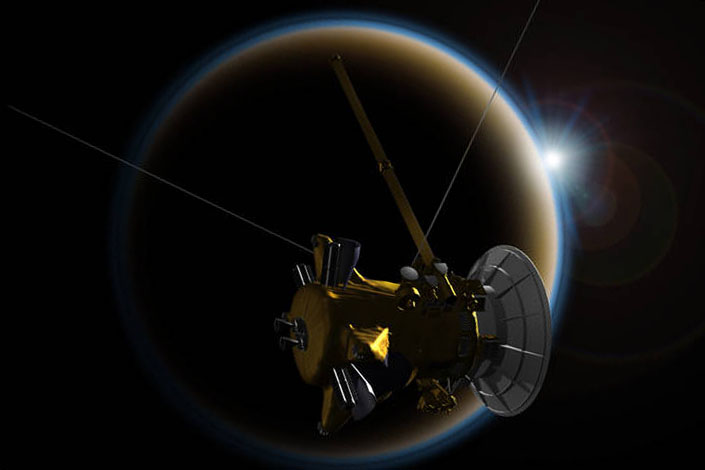
Titan’s subsurface geology is intriguing as well. Scientists think the moon has a silicate core that may still be hot. But not hot enough to cause radioactivity to produce a magnetic field around Titan. Like Mars, the satellite may once have had a magnetic field early in its history, but has since dissipated as the world cooled. Above the core lies a layer of high-pressure ices caused by the weight overlying strata. It is suspected that above this compressed ice layer is an ocean of water and ammonia that may be a niche for hearty micro-organisms. Heat transfer from the interior may be sufficient sustain aquatic biology that have adapted to extreme conditions within the moon.
Above this liquid ocean is another layer of lower-pressure ice lying closest to the surface. This is what we may be seeing in our images from Cassini.
The aspect of life on this shrouded world has been an ongoing issue for decades. Some believe that early pre-biotic conditions und on our planet are being replicated on Titan today. By looking Titan, we may be looking through a time capsule of early Earth. Experiments involving the bridging from chemical to biological olution have pointed the way to suggest that there is ample organic terial on Titan to start a chemical process analogous to what is assumed to have kick-started life on our planet. According to one model on astrobiology, an ammonia-water solution that lies 200km below a water ice crust stipulates that (while extreme by Earth standards) organisms could survive and reproduce. The transfer of heat between the inner and upper layers would be enough to sustain any sub-surface marine life. A similar scenario may play out its role on Jupiter’s moon Europa where a sub-surface ocean may be home to aquatic life.
There are many questions that beg to be answered about this dynamic world. As Cassini continues to orbit and gather more information, there will be more questions to ponder. Up till now, the mission has been a success. Scientists are even anticipating future missions to this evolving world. Issues such as budget, cost, and traveling time will play a role in determining the next chapter of this adventure. Now we know what lies beneath Titan’s orange smog.
